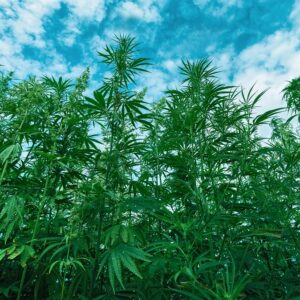Biological Carbon Capture: A Regenerative Path to Net Zero
At Jurassic Hemp, our Carbon Credit Incentive Program provides farmers with a powerful opportunity to generate revenue while contributing to the planet’s well-being. By cultivating our patented industrial hemp hybrid, Jurassic Hemp, farmers can significantly increase their land’s carbon sequestration capacity.
1. Carbon Capture
Hemp is one of the most efficient carbon-absorbing plants on Earth. It captures between 10 and 22 tons of CO₂ per hectare, outperforming forests and many traditional crops. This carbon is stored long-term in its durable fibres, which are then used in textiles, bioplastics, construction (hempcrete), and other applications—effectively locking carbon away instead of releasing it back into the atmosphere. Hemp’s fast growth cycle (up to 3 harvests per year) makes this carbon capture process highly scalable and renewable.*
2. Biodegradability & Recyclability
Hemp is 100% biodegradable. Unlike synthetic materials that persist in landfills or pollute oceans, hemp products naturally decompose without leaving harmful residues. Additionally, hemp fibres and composites can be reused or recycled into new products, supporting a circular economy that reduces waste and the need for virgin materials.


3. Water Efficiency
Hemp requires significantly less water than conventional crops like cotton. Producing 1 kilogram of hemp fabric uses around 990 litres of water, whereas cotton requires approximately 4,400 litres. This water efficiency makes hemp an environmentally responsible choice, especially in drought-prone or water-scarce regions, where sustainable water use is critical.
4. Reduced Need for Pesticides & Herbicides
Hemp’s natural resistance to pests and diseases reduces the need for harmful chemical inputs. Unlike crops that depend on synthetic pesticides, hemp can thrive with minimal intervention. This contributes to healthier soil, cleaner waterways, and greater biodiversity in and around hemp farms.
5. Phytoremediation (Soil Detoxification)
Hemp has the remarkable ability to clean contaminated soils through phytoremediation—a process where the plant absorbs heavy metals and toxins from the ground. It was famously used to help decontaminate soils after the Chernobyl nuclear disaster, demonstrating its value in environmental restoration and land rehabilitation efforts worldwide.
6. Improved Soil Health
Hemp contributes to soil regeneration by adding organic matter back into the earth after harvest. Its deep roots prevent erosion, break up compacted soil, and enhance soil structure, allowing better water retention and nutrient cycling. As a rotational crop, it also improves the yield and health of subsequent crops.
7. Sustainable Alternative to Wood Products
Hemp is a strong and fast-growing alternative to wood, capable of being harvested 3 times per year compared to the decades required for trees. It can be used to make paper, fibreboard, bioplastics, and construction materials like hempcrete. By replacing wood-based products, hemp helps combat deforestation, supports climate resilience, and preserves forest ecosystems.




